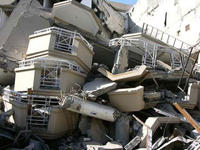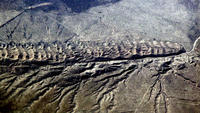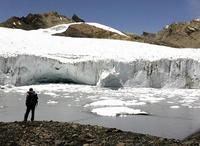-
Scientists warn solar storms could be "global Hurricane Katrina"
Scientists warn that massive solar storms could be the equivalent of a “global Hurricane Katrina”; these storms could cause $2 trillion in damages to communications equipment, power grids, and GPS systems; experts are particularly concerned about solar flares due to the increased reliance on electrical communication systems and the approach of a period of intense solar activity; solar flares can cause power surges that are powerful enough to knock out electrical grids and induce electric currents in oil pipelines; in 2013 the sun will enter a peak in its eleven year solar cycle that is expected to generate a significant number of powerful solar flares; last month a solar flare generated magnetic storms and power surges that disrupted communications and grounded flights
-
-
Engineers use Xbox Kinect to find earthquake survivors
A team of engineers at the University of Warwick in the United Kingdom has been working to develop a robot capable of entering unstable buildings and searching for survivors, such as the 200 purportedly missing after the 6.3 magnitude earthquake in Christchurch, New Zealand; until now, technology has relied on expensive laser-based equipment, but Warwick’s team has reconfigured Microsoft’s Xbox Kinect to identify places in which survivors may be
-
-
Risk-analysis models could not predict Arab world upheavals
Political instability is influenced by everything from the weather to local economic conditions and infant mortality rates; these factors interact in complex ways, and data quality can be low; together, this makes for a daunting forecasting challenge; says one expert: “All of our models are bad, some are less bad than others”
-
-
Ancient catastrophic drought a warning about current warming trends
Extreme megadrought in Afro-Asian region likely had consequences for Paleolithic cultures; the records show that one of the most widespread and intense droughts of the last 50,000 years or more struck Africa and Southern Asia 17,000 to 16,000 years ago; the “H1 megadrought” was one of the most severe climate trials ever faced by anatomically modern humans; Africa’s Lake Victoria, now the world’s largest tropical lake, dried out, as did Lake Tana in Ethiopia, and Lake Van in Turkey; the Nile, Congo, and other major rivers shriveled
-
-
NZ earthquake illustrates risks for U.S. west coast

The recent 6.3 magnitude earthquake in Christchurch, New Zealand, killed many more people and caused far more damage than the September 2010 7.1 magnitude earthquake which struck the same area; the reason: even though this earthquake was weaker than last year’s event, it was much shallower; was situated directly under Christchurch; hit during the lunch hour when more people were exposed to damage; and shook sediments that were prone to “liquefaction,” which can magnify the damage done by the ground shaking; scientists say the same description nicely fits many major cities and towns in Washington, Oregon, California, and British Columbia
-
-
Satellite system to provide earlier earthquake warnings
British and Russian scientists are planning a satellite system that will monitor seismic activity from space in the hope of one day predicting the occurrence of earthquakes and volcanic eruptions.
The TwinSat project will put one micro-sized and one nano-sized satellite into low earth orbit some 400 kilometers apart, which will work in unison to collect and interpret electromagnetic signatures from the ground -
-
Haiti's quake damage yields better building codes

In the aftermath of the 7.0 magnitude earthquake that shook Haiti last year and killed more than 300,000 people, University of Arizona researchers descended upon the country’s capital to study buildings that survived the quake; researchers documented damaged buildings to develop a sophisticated three dimensional model; they are working to develop stricter building codes to ensure that buildings can withstand earthquakes in the future; their focus is on designing low-cost easy to implement localized solutions; buildings that were not built to withstand earthquakes were the primary cause of death in the disaster
-
-
Rising seas will affect major U.S. coastal cities by 2100
The Gulf and southern Atlantic coasts will be particularly hard hit by rising sea levels, research predicts. Miami, New Orleans, Tampa, Florida, and Virginia Beach, Virginia could lose more than 10 percent of their land area by 2100
-
-
Be prepared: earthquakes big and small

The February issue of the Bulletin of the Seismological Society of America offers insights into small seismic problems — and big ones — the United States faces; there were a series of small tremors in the Dallas-Forth Worth area — home to more than four million residents that has experienced no previous earthquakes in historic time; the Coachella Valley section of the San Andreas fault, between San Gorgonio Pass and the Imperial Valley, is the only portion of the fault which has not ruptured in a major earthquake during historical time; this is not good news: This long period of quiescence suggests that an unusually large amount of elastic strain has built up along the southern San Andreas segment, making it likely to produce a large to great (Mw7-8) earthquake in the near future
-
-
Melting glaciers threaten Peru

Rising temperatures have caused glaciers in Peru to melt at alarming rates; Peru depends heavily on rivers fed by glaciers to provide drinking water, irrigation, and electricity; some scientists estimate that in ten years, whole glaciers will disappear entirely from the Andes; millions of Peruvians depend entirely on the glacier fed rivers as their primary source for water; the United States fears that water, food, and power shortages in Peru could cause stability and spark conflict across the region
-
-
Protecting vital infrastructure as sea levels rise
As the world gets warmer, sea levels are rising; it has been happening at a snail’s pace so far, but as it speeds up more and more low-lying coastal land will be lost; at risk are many of the world’s cities and huge areas of fertile farmland; the sea is set to rise a meter or more by the end of this century, swamping much vital infrastructure and displacing hundreds of millions of people; scientists are looking at various ways to slow down or reverse the rise in sea levels — and of ways of coping with its consequences
-
-
2010: a year of costly disasters
Altogether, a total of 950 natural catastrophes were recorded last year, nine-tenths of which were weather-related events like storms and floods; this total makes 2010 the year with the second-highest number of natural catastrophes since 1980, markedly exceeding the annual average for the last ten years (785 events per year); the overall losses amounted to around $130 billion, of which approximately $37 billion was insured; the five “great natural catastrophes” of 2010 — the earthquakes in Haiti (1/12), Chile (2/27), and central China (4/13), the heat wave in Russia (July to September), and the floods in Pakistan (July to September) — claimed approximately 295,000 lives
-
-
Asia faces climate-induced migration crisis
Asians accounted for 89 percent of the 207 million people affected by natural disasters globally last year; Asian governments are currently focused on mitigating weather changes induced by climate change, but a new report from the Asian Development Bank says they should start laying down policies and mechanisms to deal with the projected population shifts; weather changes such as significant temperature increases, changing rainfall patterns, greater monsoon variability, sea-level rise, floods, and more intense tropical cyclones would force millions of people to flee their homes to safer havens within countries and across borders
-
-
Pakistan floods last summer could have been predicted
Five days before intense monsoonal deluges unleashed vast floods across Pakistan last July, computer models at a European weather-forecasting center were giving clear indications that the downpours were imminent; if the information had been processed, forecasters could have predicted extremely accurate rainfall totals 8-10 days beforehand; the lack of a cooperating agreement between the forecasting center and Pakistan, however, meant that these rainfall warnings did not make it to the Pakistani people, nor did Pakistan’s own meteorological agency forecast the flooding
-
-
Minnesota will see major floods in spring
Meteorologists project major floods in Minnesota this spring; emergency response officials warn that major roadways will likely be closed and are urging residents to immediately purchase flood insurance; officials are also encouraging residents to develop evacuation plans and to begin raising appliances off of basement floors; a third particularly rainy autumn followed by double the average amount of snow is to be blamed for the floods, as excessive snow melt will swell rivers in the spring; last year similar conditions caused rampant flooding and an estimated $28 million in damages
-
More headlines
The long view
Using Drone Swarms to Fight Forest Fires
Forest fires are becoming increasingly catastrophic across the world, accelerated by climate change. Researchers are using multiple swarms of drones to tackle natural disasters like forest fires.
How Climate Change Will Affect Conflict and U.S. Military Operations
“People talk about climate change as a threat multiplier,” said Karen Sudkamp, an associate director of the Infrastructure, Immigration, and Security Operations Program within the RAND Homeland Security Research Division. “But at what point do we need to start talking about the threat multiplier actually becoming a significant threat all its own?”
